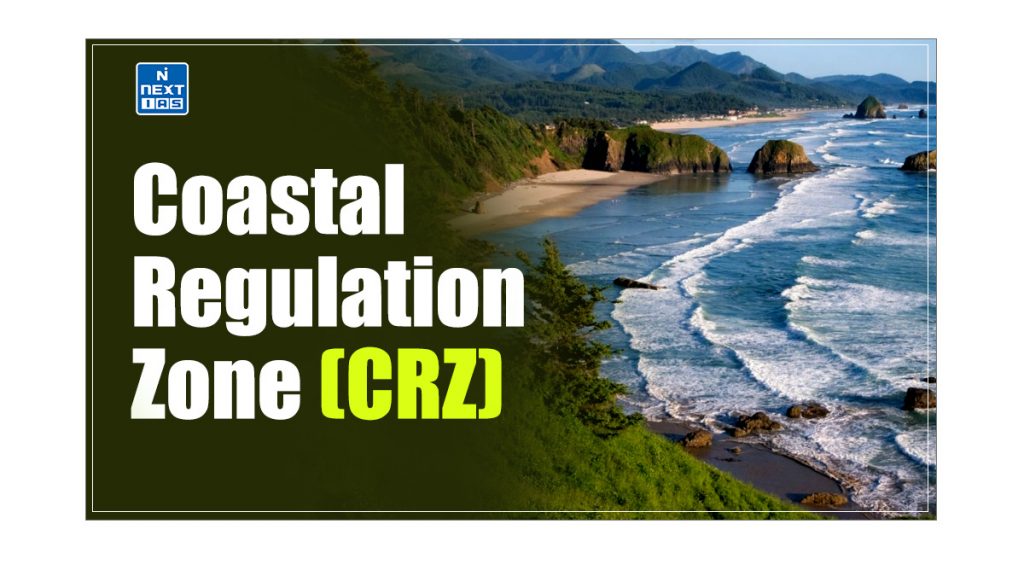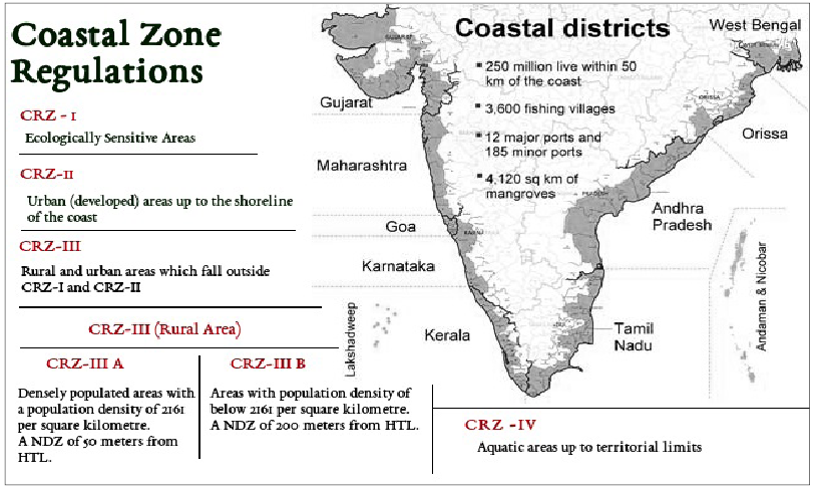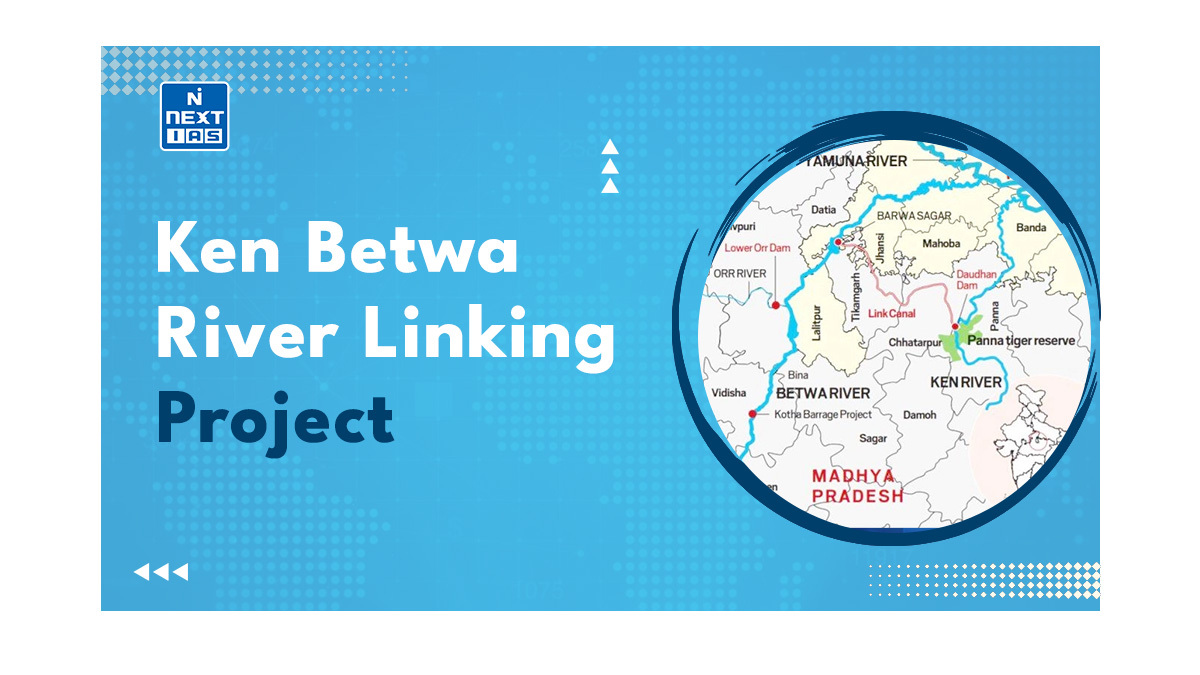
The Coastal Regulation Zone (CRZ) is a critical tool for India to manage its vast coastline in a sustainable manner. It has played a pivotal role in ensuring the dual goal of protecting fragile coastal ecosystems and ensuring sustainable development. This article aims to study in detail the Coastal Regulation Zone, its needs, key provisions, benefits, challenges and other related aspects.
What is Coastal Regulation Zone (CRZ)?
- The Coastal Regulation Zone (CRZ) refers to the areas along India’s coast that are subject to specific regulatory measures to prevent ecological damage and ensure sustainable development.
- India has a long coastline of more than 7500 km. The area near the coast is rich in biodiversity as it is an ecotone, transitioning from the terrestrial ecosystem to the marine ecosystem.
- For the purpose of protecting and conserving the coastal and marine environment, the Ministry of Environment issued the Coastal Regulation Zone Notification 1991 under the Environment Protection Act, 1986.
- The CRZ Notification 1991 was superseded by CRZ Notification, 2011 and Island Protection Zone (IPZ) Notification, 2011 under the Environment (Protection) Act, 1986.
- These regulations aim to manage coastal and island zone activities in a way that protects coastal ecosystems, minimises coastal erosion, and safeguards the livelihoods of coastal communities.
Objectives of Coastal Regulation Zone
Some of the major objectives of the Coastal Regulation Zone are as follows:
- To ensure livelihood security for the fishing and other local communities living in the coastal areas.
- To protect and conserve coastal stretches, its unique environment and marine area.
- To promote sustainable development based on scientific principles, taking into account the dangers of natural hazards in the coastal areas, and sea level rise due to global warming.
Key Provisions Regarding Coastal Regulation Zone
Key Provisions of the Coastal Regulation Zone Notification are as follows:
- Under Section 3 of the Environment (Protection) Rules, 1986, the Central Government declares the following:
- The coastal stretches of rivers, seas, bays, estuaries, creeks, and backwaters which are influenced by tidal action (on the landward side) up to 500 meters from the High Tide Line (HTL)
- The land between the Low Tide Line (LTL) and the HTL as Coastal Regulation Zone.
- The High Tide Line means the line on the land up to which the highest water line reaches during the spring tide.
- The High Tide Line (HTL) shall be demarcated uniformly across the country by the demarcating authorities so authorised by the Central Government.
- The distance up to which development along rivers, creeks and backwaters is to be regulated shall be governed by the distance up to which the tidal effect of sea is experienced in rivers, creeks or backwaters.
- It provides a more specific regime by continuing the demarcation of the Coastal Areas into different zones and by defining what kind of activities are prohibited and permitted in these areas, namely, in CRZ-I to CRZ-IV as well as two other specific zones.
Various Zones under CRZ Notification
The Coastal Regulation Zone Notification has categorised the coastal areas into the following four zones:
CRZ-I
CRZ-I includes the following types of areas:
- Areas that are ecologically important and sensitive, such as national parks/marine parks, wildlife sanctuaries, reserve forests, wildlife habitats, mangroves, corals/coral reefs, and areas close to breeding of marine life.
- Areas of outstanding natural beauty/historical/heritage areas.
- Areas rich in genetic diversity.
- Areas likely to be inundated due to rise in sea level consequent upon global warming.
- Such other areas as may be declared by the Central Government or the concerned authorities at the State/Union Territory level from time to time.
- Area between the Low Tide Line (LTL) and the High Tide Line (HTL).
CRZ-II
CRZ-II includes the following types of areas:
- The areas that have already been developed up to or close to the shoreline. For this purpose, the developed area is referred to as that area within the municipal limits.
- Other legally designated urban areas that are already significantly developed and equipped with drainage, access roads, and essential infrastructure such as water supply and sewerage systems.
CRZ-III
CRZ-III includes the following types of areas:
- Areas that are relatively undisturbed and those that do not belong to either Category I or II. These will include coastal zones in the rural areas (developed and undeveloped).
- Areas within Municipal limits or in other legally designated urban areas that are not substantially built up.
CRZ-IV
CRZ-IV includes – Coastal stretches in the Andaman & Nicobar, Lakshadweep and small islands, except those designated as CRZ-I, CRZ-II or CRZ-III.

Restrictions Imposed under CRZ Notification
It imposes the following restrictions on setting up and expansion of industries, operations or processes, etc., in the said Coastal Regulation Zone.
- Setting up of new industries and expansion of existing industries, except those directly related to water front or directly needing foreshore facilities and Projects of the Department of Atomic Energy;
- Manufacture, handling, storage or disposal of hazardous substances as specified in the Notifications of the Government of India, except transfer of hazardous substances from ships to ports, terminals and refineries and vice versa in the port area.
- Setting up and expanding fish processing units, including warehousing
- Discharge of untreated wastes and effluents from industries, cities or towns and other human settlements.
- Dumping of city or town waste for the purposes of landfilling or otherwise.
- Dumping of ash or any wastes from thermal power stations.
- Land reclamation, bunding or disturbing the natural course of sea water except those required for construction or modernization or expansion of ports, harbors etc.
- Mining of sands, rocks and other substrata materials, except those rare minerals not available outside the Coastal Regulation Zone and exploration and extraction of Oil and Natural Gas
- Harvesting or drawal of groundwater and construction of mechanisms therefor within 200 m of HTL; in the 200m to 500m zone, it shall be permitted only when done manually through ordinary wells for drinking, horticulture, agriculture and fisheries
Activities Permitted in Coastal Regulation Zone
- Coastal Regulation Zone Notification includes provisions regarding the clearance of activities that are permissible with prior clearance from the concerned state authorities.
- The rules for different Coastal Regulation Zones are as follows:
CRZ-I
- No new construction shall be permitted in CRZ-I except projects relating to the Department of Atomic Energy and other major infrastructure projects such as for example, pipelines, construction of trans-harbor sea link and roads, and the Green Field Airport.
- Area between the HTL and LTL, which are not ecologically sensitive, some minor projects such as the exploration and extraction of natural gas, and the construction of dispensaries, schools, public rain shelters, are permitted.
CRZ-II
Activities and structures permitted in CRZ-II are, for example, the construction or reconstruction of buildings, facilities for receipt and storage of petroleum products, and notified ports.
CRZ-III
- The activities includes establishing a ‘No Development Zone’ within the area up to 200 m from the HTL on the landward side in the case of seafront and 100 m along tidal influenced water bodies or width of the creek.
- In these areas, no construction shall be permitted except for the repair or reconstruction of existing authorised structures, though there are some exceptions to this rule also.
CRZ-IV
- Coastal towns and cities are required to formulate sewage treatment plans and implement them within a period of one year.
- Traditional fishing rights of local communities shall not be restricted.
- It envisages the preparation of Coastal Zone Management Plans (CZMP) by all the coastal states.
- These plans guide the regulation and development of those activities listed in the Coastal Regulation Zone Notification.
- State Governments and Union Territories are required to prepare CZMPs for their respective coastal areas.
Challenges in Coastal Regulation
- The planning requirements under the Coastal Regulation Zone Notification remain somewhat open-ended and unspecific.
- The coastal regulation rules lack a clear vision of how and to what extent threatened coastal areas need to be protected and which measures are actually required.
- Though, in principle, the regulatory structure of the Notification is rather simple, both clarity and accessibility are heavily confined by the wide use of vague legal terms.
- The use of clear, precise and comprehensible terms creates clarity and certainty regarding rights, duties and competencies for those who implement the Notification and those who are affected by it.
- Other things that it lacks are public participation, transparency in the application process, access to courts for public environmental litigation, and adequate administrative capacities.
CRZ Notification, 2018
The Coastal Regulation Zone, 2018, was released by the Ministry of Environment and Forests (MoEF). Its major provisions can be seen as follows:
- The High Tide Line (HTL) has been demarcated by the National Centre for Sustainable Coastal Management (NCSCM) and shall be reckoned as a universal standard for the HTL for all regulatory purposes under the Coastal Regulation Zone Notification, 2018.
- Hazard line mapping has also been carried out by the Survey of India. The Hazard Line has, however, been delinked from the coastal zone regulatory regime and shall be used only as a tool for Disaster Management and planning of adaptive and mitigation measures.
- Coastal Regulation Zone limits on land along the tidal-influenced water bodies has been proposed to be reduced from 100 meters or the width of the creek, whichever is less, to 50 meters or the width of the creek, whichever is less.
- A No Development Zone (NDZ) of 20 meters has been proposed to be stipulated for all Islands close to the mainland coast and for all Backwater Islands on the mainland.
- For CRZ-III areas, two separate categories have been proposed, viz.:
- CRZ-III A: Densely populated rural areas with a population density of above 2161 per square kilometre as per the 2011 Census. Such areas shall have an NDZ of 50 meters from the HTL as opposed to 200 meters from the HTL stipulated in the CRZ Notification, 2011.
- CRZ-III B: Rural areas with a population density of below 2161 per square kilometre as per the 2011 Census. Such areas shall continue to have an NDZ of 200 meters from the HTL.
- The procedure for clearances has been simplified and delegations have been made at various levels for recommending or according clearances to the projects/activities.
- Only such projects/activities, which are located in the CRZ-I & IV areas, shall be dealt with for clearance by the MoEF&CC.
- For all other project activities located in CRZ-II/III areas, clearance shall be considered at the CZMA level.
- Temporary tourism facilities such as shacks, toilet blocks, change rooms, drinking water facilities etc. have been proposed in Beaches. Such temporary tourism facilities are also proposed to be permissible in the No Development Zone (NDZ) of the CRZ-III areas.
- Regulated limestone mining is proposed to be permitted, subject to strict environmental safeguards, in areas adequately above the height of HTL, based on recommendations of reputed National Institutes in the Mining field.
Conclusion
The Coastal Regulation Zone regulations are a vital tool for protecting India’s coastal ecosystems while enabling sustainable development along the coastline. As India continues to urbanise and industrialise, balancing environmental conservation with developmental goals becomes increasingly crucial.
Strengthening the implementation of coastal regulations, enhancing community awareness, and adopting a more integrated approach to coastal management are essential steps toward ensuring that India’s coastlines remain resilient, productive, and biodiverse for future generations.
Frequently Asked Questions (FAQs)
What is the full form of CRZ?
CRZ stands for Coastal Regulation Zone.
Who regulates CRZ?
In India, the Coastal Regulation Zone is regulated by the Union Ministry of Environment and Forest.






